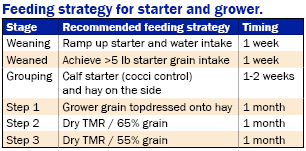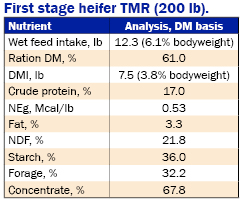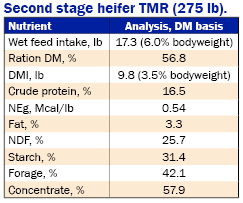
Transition heifer nutrition – Cody Yanzick, Vita Plus
Click here to download Yanzick’s PowerPoint presentation.
 We tend to see greater emphasis put on calf and cow nutrition while heifers are pushed to the back of the mind. Although many consider a good, early start and maintaining production later on most important, nutrition during the transition period is what helps prepare the cow for long-term production.
We tend to see greater emphasis put on calf and cow nutrition while heifers are pushed to the back of the mind. Although many consider a good, early start and maintaining production later on most important, nutrition during the transition period is what helps prepare the cow for long-term production.
The goals of a successful transition program, as outlined by Cody Yanzick, Vita Plus dairy specialist at Vita Plus Calf Summit, are to minimize stressors and maintain health. This begins by continuing many of the same practices done during the weaning period.
Specifically, Yanzick said the nutrition program should continue developing the calf’s rumen. A well-developed rumen is necessary to digest the forages given and be productive later in life. Calves can only handle so much at one time while their rumen develops, and this can be accomplished through the gradual introduction of forages into their diets.
Yanzick provided a good outline for making the transition between feeds.

When you begin to transition, Yanzick said to continue feeding starter grain at 3 to 4 percent of their bodyweight, and slowly start introducing small amounts of high-quality grass hay on the side. Many producers offer the hay with grain top-dressed on it; this also works and provides an initial introduction to forages to help rumen development.
At three months of age, the heifers can be fed a total mixed ration (TMR) with 3 to 4 pounds of starter grain top-dressed. This first stage TMR should have 35 percent forage dry matter and lower protein content than the starter grain to begin the transition from high-protein starters. Heifers should achieve an ADG of 2.10 pounds at this point.
After 30 days, the first stage TMR is replaced with the second stage TMR. This TMR continues the trend with lower protein and higher forages and provides an ADG of 2.25 pounds.
Yanzick provided examples of the first and second stage TMR compositions.


Yanzick said using a uniformly mixed TMR holds many advantages over a grain/hay diet:
- Prevents selective eating
- Better control of intakes
- More uniform calves
- Makes competition a non-factor
- Offers vitamins and trace minerals
Considering 10 to 40 percent of transition calves will get sick, the provision of vitamins and minerals is important because we need to build the calf’s immune system, Yanzick explained.
“We need to feed the immune system and provide what we can to keep them healthy,” he said.
A “one-size-fits-all” transition plan doesn’t exist; you need to find what works for your facility, write it down to avoid miscommunication, and minimize the effects of any stressors.
To further ease the transition process, Yanzick provided five keys to a successful program:
- Ensure adequate calf age, size and starter intake (rumen development) coming into the transition group.
- Maintain starter and water intake.
- Transition calves onto a diet with some forage and move to a TMR 3 months of age.
- Keep them in modest-sized groups; four to six calves work best.
- Maintain adequate bedding and ventilation.
| Category: |
Calf and heifer nutrition Starting Strong - Calf Care |

